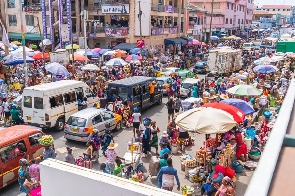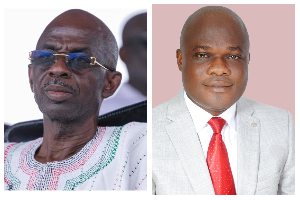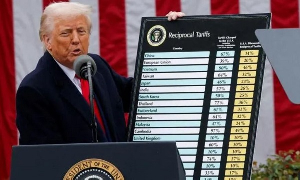The year 2023 was a period of economic stabilisation and the beginning stages of recovery for the country, following a turbulent 2022 that saw high inflation, currency depreciation, and an economic crisis. With the government launching critical debt restructuring programmes and securing a US$3billion IMF Extended Credit Facility (ECF) to support economic recovery, the building blocks were laid for macroeconomic stabilisation.
Ghana’s economic journey in 2023 reflects a mix of challenges, resilience and transformation. While strides were made in stabilising inflation, improving fiscal balances and restructuring debt, the decline in private sector credit poses concerns for sustained growth.
Early signs of economic turnaround
In the first half of 2023, the nation saw higher economic growth beyond the targets for the period, averaging 3.2 percent compared to 2.9 percent in the same period in 2022, signalling a strong rebound driven by robust growth in services. However, growth at the end of Q3 eased to 2 percent compared to 2.7 percent in the same period of 2022. The 2 percent average growth exceeds the revised 2023 target of 1.5 percent, indicating the likelihood of surpassing full-year expectations. This early momentum gave hope that the painful policy adjustments were starting to yield dividends.
The structure of the economy remain largely unchanged, with services accounting for 46.1 percent of gross domestic product (GDP) in the first half of 2023 while agriculture and industry had 21.4 percent and 32.5 percent shares, respectively. However, by the Q3 2023, services accounted for 42.1 percent of gross domestic product (GDP) while agriculture and industry had 24. 9 percent and 33 percent shares, respectively.
On the policy front, fiscal consolidation efforts are on track to meet IMF targets, exchange rate stability largely achieved on the back of the halt in servicing of external debts amid the Bank of Ghana’s gold for reserves and gold for oil programmes, and inflation saw steady declines throughout the year.
Bringing down inflation
A key economic priority was tackling high inflation, which hit 54.1 percent in December 2022. Price stability is essential for planning by households and businesses and supports sustainable growth. The government implemented fiscal discipline, a tight monetary policy, and relative exchange rate stability. These measures, along with favourable base effects, drove broad-based disinflation.
Consumer inflation now stands at 26.4 percent in November 2023, from 35.2 percent in October 2023. Food price pressures moderated abruptly in November 2023, as food inflation recorded a significant deceleration by 1,260bps to 32.2 percent y/y – the sharpest fall since January 2023.
Non-food inflation also remained on a disinflationary course, falling by 600bps to 21.70 percent y/y in November 2023. Barring July 2023 which witnessed an uptick in non-food inflation, the decline in November 2023 marks the tenth successive fall in non-food inflation since January 2023.
The disinflation process began earlier in the year when inflation started scaling down from 43.1 percent in July 2023 to 40.1 percent in August. Despite occasional fluctuations, the trend has been predominantly downward, marking a cumulative decline of 27.7 percent since its peak in December 2022 at 54.1 percent.
With easing underlying price pressures, inflation has surpassed the central bank’s year-end target of around 29 percent as well as the government’s year-end inflation target of 31.3 percent, as outlined in the 2023 Mid-Year Budget Review.
Stabilising the cedi
In 2022, the Ghana cedi depreciated drastically by over 50 percent against the US dollar. However, in 2023, the cedi staged an impressive turnaround, appreciating by 66 percent between February to November, excluding a depreciation episode in January. This contrasted sharply with the prior year’s 54 percent cumulative fall over the same period.
The revival of economic activity and restoration of confidence provided pivotal support. Other helpful factors included FX inflows from the IMF and gold purchases by the central bank, reduced FX demand from a confident market, and Bank of Ghana market interventions. On the external front, strong prices for Ghana’s major export commodities like cocoa, gold and oil also bolstered the cedi and the balance of payments.
By October, gross international reserves rose to US$2.5billion from US$1.5billion in December 2022, offering an important buffer for absorbing shocks, according to the 2024 Budget.
Getting public finances on track
Fiscal consolidation was at the core of restoring macroeconomic stability in 2023. Having witnessed large budget deficits and explosive debt growth in recent years, it remained crucial for government to embrace fiscal discipline. The government worked toward improving the primary fiscal balance while scaling back non-essential expenditures. There was visible headway – the budget deficit narrowed to 2.9 percent of GDP between January to October 2023, beating the target of 5.1 percent.
On the critical debt front, completion of the debt exchange programme helped reduce total public debt to GDP to 66.4 percent by September 2023 from 38.1 percent in 2022, slowing down debt accumulation significantly. Successful external debt restructuring efforts in 2024 would provide additional debt relief.
Impact on private sector credit
While many economic indicators improved during 2023, private sector credit growth worsened substantially. Year-on-year credit growth contracted by 31.6 percent in real terms as of October 2023 – a sharp deterioration from 3 percent growth in 2022.
Banks shifted toward lower-risk assets like short-term government debt instead of expanding lending, driven by heightened perceptions of credit risk and the profitability of alternative investments. Their risk aversion tendencies were reflected in surging non-performing loans which hit 18.3 percent.
This decline in private sector credit access amid early stages of economic recovery is worrying as it risks hampering long-term growth prospects. Addressing this should be a policy priority going forward. However, heavy domestic borrowing planned by government for 2024 spending may crowd out the private sector further.
Cautious optimism for 2024
Overall, 2023 marked the turning point for Ghana after a very difficult 2022 economic crisis. Though still facing substantial headwinds, the building blocks are in place for a sustained recovery over the medium term. The government set a 2024 GDP growth target of at least 2.8 percent, with an ambition to reach 5 percent by 2027.
Other 2024 targets include keeping inflation around 15 percent while improving international reserves to cover 3 months of imports. To achieve these aims and cement macroeconomic stability, staying the course on structural reforms and fiscal measures aligned with IMF programme goals is imperative.
Remaining risks around external factors like commodity prices, climate impacts on agriculture, and the success of debt restructuring negotiations will continue to cloud the outlook. However, if government builds on 2023’s hard-fought gains, there are reasons for cautious optimism for economic prosperity over the coming years.
Business News of Thursday, 28 December 2023
Source: thebftonline.com













